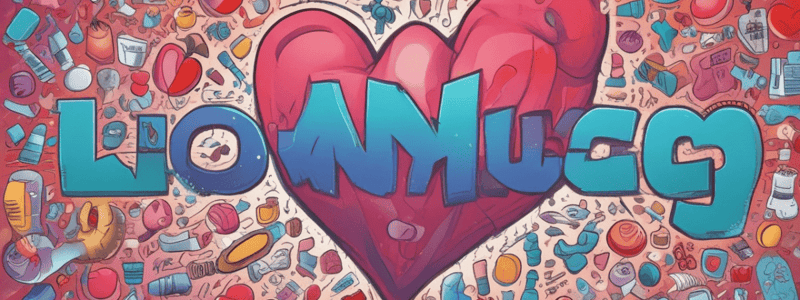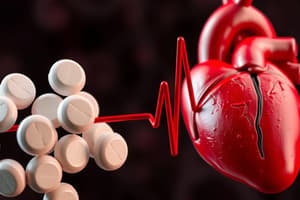Podcast
Questions and Answers
Which class of antiarrhythmics decrease heart contractility by causing a blockade of calcium channels in the SA and AV nodes?
Which class of antiarrhythmics decrease heart contractility by causing a blockade of calcium channels in the SA and AV nodes?
- Class V
- Class II
- Class IV (correct)
- Class I
What is the primary indication for Amiodarone?
What is the primary indication for Amiodarone?
- Long QT syndrome
- Ventricular tachycardia (correct)
- Ventricular fibrillation
- Atrial fibrillation
What is the mechanism of action for Class I antiarrhythmics?
What is the mechanism of action for Class I antiarrhythmics?
- Sodium channel blockade (correct)
- Potassium channel blockade
- Beta-adrenergic receptor blockade
- Calcium channel blockade
Which of the following is a major risk associated with Class 1A sodium channel blockers?
Which of the following is a major risk associated with Class 1A sodium channel blockers?
What is the mechanism of action for Adenosine?
What is the mechanism of action for Adenosine?
What is the effect of Amiodarone on the QT interval?
What is the effect of Amiodarone on the QT interval?
What is the mechanism of action for Anticoagulants?
What is the mechanism of action for Anticoagulants?
Which of the following is a Class III antiarrhythmic?
Which of the following is a Class III antiarrhythmic?
What is the standard form of heparin?
What is the standard form of heparin?
What is the MOA of heparin?
What is the MOA of heparin?
What are the two main uses of heparin?
What are the two main uses of heparin?
Can heparin be taken orally?
Can heparin be taken orally?
What is the reason to avoid heparin via the IM route?
What is the reason to avoid heparin via the IM route?
What is the reversal agent for heparin toxicity?
What is the reversal agent for heparin toxicity?
What is Heparin-induced Thrombocytopenia (HIT)?
What is Heparin-induced Thrombocytopenia (HIT)?
What is the class of drugs that promotes the lysis of fibrin and the dissolution of thrombi?
What is the class of drugs that promotes the lysis of fibrin and the dissolution of thrombi?
What is the MOA of thrombolytics?
What is the MOA of thrombolytics?
What is the difference between anticoagulants and thrombolytics?
What is the difference between anticoagulants and thrombolytics?
In a patient with Long QT syndrome, which medication should be avoided?
In a patient with Long QT syndrome, which medication should be avoided?
What is the sensation felt by a patient experiencing Torsedes De Pointes?
What is the sensation felt by a patient experiencing Torsedes De Pointes?
Which of the following antiarrhythmic classes does NOT decrease heart contractility?
Which of the following antiarrhythmic classes does NOT decrease heart contractility?
What is the primary mechanism of action of beta blockers?
What is the primary mechanism of action of beta blockers?
Which of the following antiplatelet drugs is a prototype?
Which of the following antiplatelet drugs is a prototype?
What is the mechanism of action of thrombolytics?
What is the mechanism of action of thrombolytics?
Which of the following is NOT a risk associated with Class 1A sodium channel blockers?
Which of the following is NOT a risk associated with Class 1A sodium channel blockers?
What is the primary effect of Adenosine on the heart?
What is the primary effect of Adenosine on the heart?
What is the primary function of anticoagulants?
What is the primary function of anticoagulants?
Which of the following is a side effect of beta blockers?
Which of the following is a side effect of beta blockers?
What is the mechanism of action of Class II antiarrhythmics?
What is the mechanism of action of Class II antiarrhythmics?
Which of the following is a route of administration for heparin?
Which of the following is a route of administration for heparin?
What is the primary indication for Class III antiarrhythmics?
What is the primary indication for Class III antiarrhythmics?
What is a common side effect of amiodarone?
What is a common side effect of amiodarone?
What is the mechanism of action of thrombolytics?
What is the mechanism of action of thrombolytics?
What is the primary indication for thrombolytics?
What is the primary indication for thrombolytics?
What is the reversal agent for heparin toxicity?
What is the reversal agent for heparin toxicity?
What is Heparin-induced Thrombocytopenia (HIT)?
What is Heparin-induced Thrombocytopenia (HIT)?
Flashcards are hidden until you start studying
Study Notes
Medications for Long QT Syndrome
- In an acute setting, magnesium sulfate is given to patients with Long QT syndrome.
Antiarrhythmic Drugs and QT Prolongation
- Class I (Sodium channel blockers, e.g., Quinidine) and Class III (Potassium Channel Blockers, e.g., Amiodarone) antiarrhythmic drugs increase the risk of QT prolongation.
- Other medications associated with increased risk of QT prolongation include antipsychotics, antidepressants, and antibiotics.
Torsedes De Pointes
- A patient experiencing Torsedes De Pointes feels skipped beats, palpitations, racing heart, and chest discomfort/pain/pressure.
- QT prolongation occurs when repolarization takes longer than depolarization, causing the heart to relax and then receive another beat during that relaxation period.
Antiarrhythmic Drug Classes
- Class I: Sodium channel blockers (e.g., Quinidine) decrease heart contractility by blocking sodium channels in the SA node and AV node.
- Class II: Beta blockers (e.g., Propranolol) decrease heart contractility by blocking beta receptors in the SA node and AV node.
- Class III: Potassium Channel Blockers (e.g., Amiodarone) decrease heart contractility by blocking potassium channels in the SA node and AV node.
- Class IV: Calcium Channel Blockers (e.g., Verapamil) decrease heart contractility by blocking calcium channels in the SA node and AV node.
- Class V: Others (e.g., Adenosine) decrease heart contractility by blocking various channels in the SA node and AV node.
Beta Blockers
- Beta blockers belong to Class II antiarrhythmics.
- Mechanism of action: decrease the automaticity of the SA node and slow conduction through the AV node, helping to control tachyarrythmias.
- Clinical uses: antihypertension, heart failure, angina, myocardial infarction, arrhythmias.
- Types:
- Non-selective (e.g., Propranolol): cause bradycardia, hypotension, and broncospasms.
- Beta 1 selective (e.g., Metopralol, Atenelol): slow down heart rate, preferred for patients with respiratory issues.
- Non-selective with additional actions (e.g., Carvedilol, Labetalol): also block alpha 1, helping with hypertension.
Class III Antiarrhythmic: Amiodarone
- Prototype drug for Class III antiarrhythmics.
- Mechanism of action: blocks potassium channels, preventing efflux of potassium from the cell, leading to delayed repolarization of the cardiac cell membrane.
- Uses: primarily indicated for ventricular arrhythmias.
- Side effects: pulmonary toxicity, thyroid dysfunction, hepatotoxicity, optic neuropathy, blue-gray skin color changes, hypotension, bradycardia, and QT prolongation.
- Can accumulate in tissues due to its lipophilic nature, leading to toxicity.
- Crosses the blood-brain barrier.
Anticoagulants
- Mechanism of action: disrupt the coagulation cascade, ultimately suppressing the production of fibrin.
- Do not break up existing clots, but rather prevent the development of future clots.
- Classes:
- Heparin and its derivatives (e.g., Enoxaparin)
- Warfarin
- Direct Oral Anticoagulants (DOACs): Dabigatran, Rivaroxaban, Apixaban
Antiplatelet Drugs
- Mechanism of action: inhibit platelet aggregation, preventing platelets from clumping together to form clots.
- Prototype drugs: Aspirin, Clopidogrel, Ticagrelor
Thrombolytics
- Mechanism of action: promote the lysis (breaking) of fibrin and the dissolution of thrombi.
- Prototype drug: tPA alteplase
- Uses: break up existing clots.
Heparin
- Standard form: unfractionated heparin.
- Lower molecular form: Enoxaparin.
- Mechanism of action: activates antithrombin, which inactivates clotting factors Xa and thrombin, preventing the conversion of fibrinogen to fibrin.
- Routes of administration: subQ, IV.
- Not absorbed through the digestive system, so cannot be taken orally.
- Should be avoided via the IM route to prevent hematoma formation.
- Uses: prophylactic (prevents clots from forming in those with risk of clots, such as Afib) and prevents current clots from getting bigger (those with DVT).
- Side effects: bleeding, bloody stool, vomiting that looks like coffee grounds, petechiae.
- Reversal agent: Protamine Sulfate.
- Can cause Heparin-induced Thrombocytopenia (HIT), an immune response against heparin.
Medications for Long QT Syndrome
- In an acute setting, magnesium sulfate is given to patients with Long QT syndrome.
Antiarrhythmic Drugs and QT Prolongation
- Class I (Sodium channel blockers, e.g., Quinidine) and Class III (Potassium Channel Blockers, e.g., Amiodarone) antiarrhythmic drugs increase the risk of QT prolongation.
- Other medications associated with increased risk of QT prolongation include antipsychotics, antidepressants, and antibiotics.
Torsedes De Pointes
- A patient experiencing Torsedes De Pointes feels skipped beats, palpitations, racing heart, and chest discomfort/pain/pressure.
- QT prolongation occurs when repolarization takes longer than depolarization, causing the heart to relax and then receive another beat during that relaxation period.
Antiarrhythmic Drug Classes
- Class I: Sodium channel blockers (e.g., Quinidine) decrease heart contractility by blocking sodium channels in the SA node and AV node.
- Class II: Beta blockers (e.g., Propranolol) decrease heart contractility by blocking beta receptors in the SA node and AV node.
- Class III: Potassium Channel Blockers (e.g., Amiodarone) decrease heart contractility by blocking potassium channels in the SA node and AV node.
- Class IV: Calcium Channel Blockers (e.g., Verapamil) decrease heart contractility by blocking calcium channels in the SA node and AV node.
- Class V: Others (e.g., Adenosine) decrease heart contractility by blocking various channels in the SA node and AV node.
Beta Blockers
- Beta blockers belong to Class II antiarrhythmics.
- Mechanism of action: decrease the automaticity of the SA node and slow conduction through the AV node, helping to control tachyarrythmias.
- Clinical uses: antihypertension, heart failure, angina, myocardial infarction, arrhythmias.
- Types:
- Non-selective (e.g., Propranolol): cause bradycardia, hypotension, and broncospasms.
- Beta 1 selective (e.g., Metopralol, Atenelol): slow down heart rate, preferred for patients with respiratory issues.
- Non-selective with additional actions (e.g., Carvedilol, Labetalol): also block alpha 1, helping with hypertension.
Class III Antiarrhythmic: Amiodarone
- Prototype drug for Class III antiarrhythmics.
- Mechanism of action: blocks potassium channels, preventing efflux of potassium from the cell, leading to delayed repolarization of the cardiac cell membrane.
- Uses: primarily indicated for ventricular arrhythmias.
- Side effects: pulmonary toxicity, thyroid dysfunction, hepatotoxicity, optic neuropathy, blue-gray skin color changes, hypotension, bradycardia, and QT prolongation.
- Can accumulate in tissues due to its lipophilic nature, leading to toxicity.
- Crosses the blood-brain barrier.
Anticoagulants
- Mechanism of action: disrupt the coagulation cascade, ultimately suppressing the production of fibrin.
- Do not break up existing clots, but rather prevent the development of future clots.
- Classes:
- Heparin and its derivatives (e.g., Enoxaparin)
- Warfarin
- Direct Oral Anticoagulants (DOACs): Dabigatran, Rivaroxaban, Apixaban
Antiplatelet Drugs
- Mechanism of action: inhibit platelet aggregation, preventing platelets from clumping together to form clots.
- Prototype drugs: Aspirin, Clopidogrel, Ticagrelor
Thrombolytics
- Mechanism of action: promote the lysis (breaking) of fibrin and the dissolution of thrombi.
- Prototype drug: tPA alteplase
- Uses: break up existing clots.
Heparin
- Standard form: unfractionated heparin.
- Lower molecular form: Enoxaparin.
- Mechanism of action: activates antithrombin, which inactivates clotting factors Xa and thrombin, preventing the conversion of fibrinogen to fibrin.
- Routes of administration: subQ, IV.
- Not absorbed through the digestive system, so cannot be taken orally.
- Should be avoided via the IM route to prevent hematoma formation.
- Uses: prophylactic (prevents clots from forming in those with risk of clots, such as Afib) and prevents current clots from getting bigger (those with DVT).
- Side effects: bleeding, bloody stool, vomiting that looks like coffee grounds, petechiae.
- Reversal agent: Protamine Sulfate.
- Can cause Heparin-induced Thrombocytopenia (HIT), an immune response against heparin.
Studying That Suits You
Use AI to generate personalized quizzes and flashcards to suit your learning preferences.




